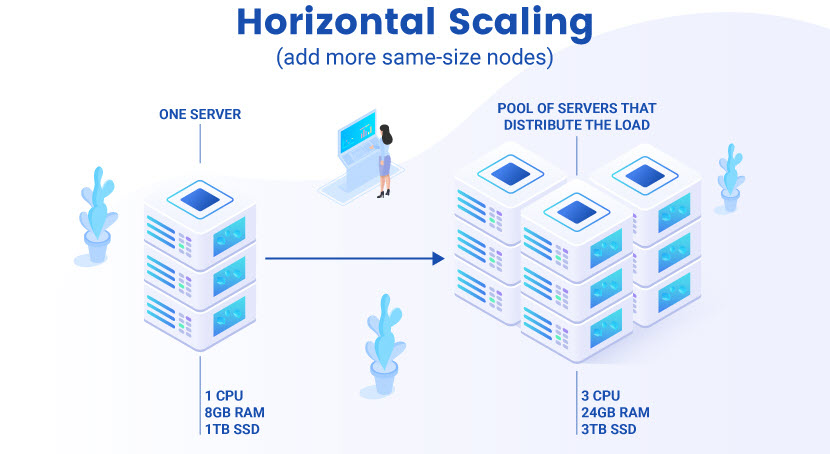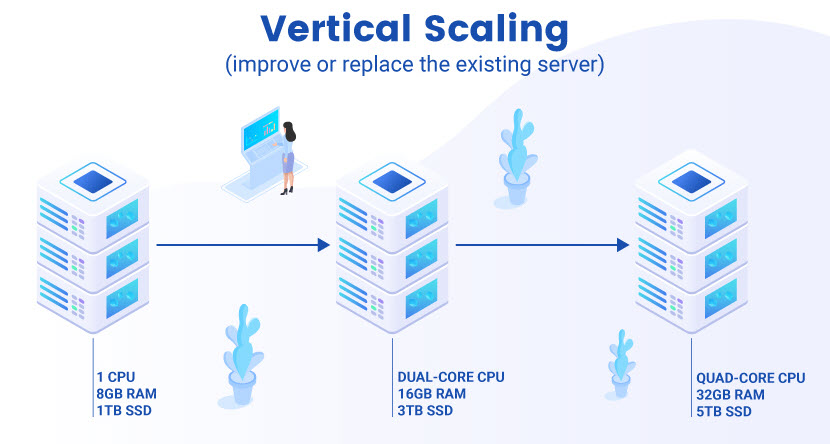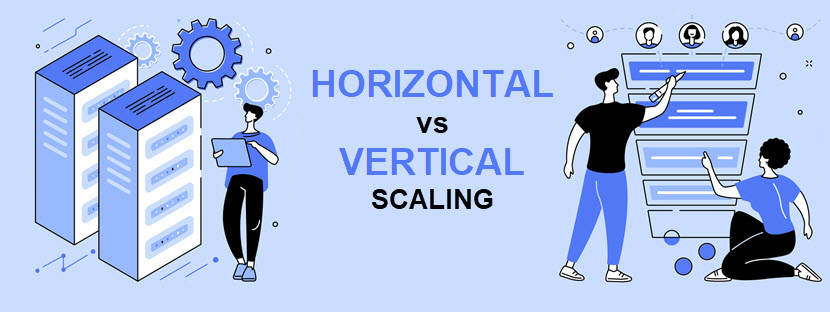You have two choices when you want to expand an IT system in order to handle an increase in load. Both strategies require adding resources (RAMs, CPUs, hard drives, etc.). to computing infrastructure, but the two come with different benefits and challenges.
So, when demand for your app or website goes up, should you scale horizontally or vertically?
This article offers a detailed comparison of horizontal and vertical scaling, two distinct strategies for adding more resources to an IT system. Read on to learn the differences between the two scaling models and see which one is a better fit for your use case.What Is Scalability?
Scalability is the capability of a computer system (hardware or software) to continue functioning well when it changes in size or volume. A scalable system seamlessly expands to meet the increased customer demand and larger workloads without impacting service quality.
Every IT system (website, app, database, etc.) Every IT system (website, app, database, etc.) has a scalability Limit at which point it cannot handle additional demand without issue. Scaling a computer system is the only way to increase its scalability. A sysadmin scales a machine by improving one (or more) of the following:Disk I/O.
The central processing unit (CPU).
- Memory/storage.
- Network bandwidth.
- You can also scale a system down. This involves reducing the system’s capacity in order to reduce IT costs and eliminate wasteful spending. Scaling down is common in cloud computing as sysadmins look to control cloud computing costs by optimizing resource utilization.
- Scaling (up or down) is either permanent or temporary. Temporary scaling is the go-to option when a company expects a short-term burst of traffic or activity that will pass over time (e.g., when an ecommerce website prepares for the holiday season).
There are two strategies for expanding a system’s capabilities:
Horizontal scaling
(adding more servers to the resource pool and distributing the load across more devices).
- Vertical scaling (upgrading the current machine with more or better components, such as adding a new CPU or extra RAM to the server).
- Let’s take an in-depth look at both scaling models and see what they offer.What Is Horizontal Scaling?
Horizontal scaling (or “scaling out”) refers to adding more nodes to a system’s resource pool to meet the increased demand. You do not improve the specifications of the existing machine–instead, you add more same-size servers to the cluster and share the workload across more devices.Scaling out enables a sysadmin to combine the power of multiple machines to meet the current load demands. Nodes do not have to be in the same data center, they do not have to be in the same region even.
Horizontal Scaling Advantages
Systems that scale out have no scalability cap. The only limits to how much you scale horizontally are the budget and data center space.

Distributing data and operations among nodes increases fault tolerance. If one of the servers goes down, the rest of the system keeps services online and maintains availability.
- The system does not go offline during the scaling process.
- Systems that scale out also enable you to reduce capacity seamlessly, so you’re not stuck always paying for peak demand.
- A skilled team knows how to set up a system that scales out automatically (in both ways).
- Sysadmins get to distribute data backups across several nodes.
- Horizontal Scaling Disadvantages
- You must add software for load balancing and ensure nodes synchronize effectively. This setup is challenging for less experienced teams.
Day-to-day server management gets more complex the more nodes you add to a system.
- Data consistency is a concern due to cross-server communication.
- Node-to-node communication slows down performance in a poorly optimized cluster.
- Servers still encounter hardware limits if machines are too small.
- Each new server requires more space, cooling, and power, so the costs of scaling out quickly spiral out of control.
- More nodes create a larger attack surface and lead to more complex incident response planning.
- Here’s a simple analogy for explaining what scaling out means. Imagine you want to go on a road trip with three friends in a car that has four seats. What do you do if an extra three people want to tag along?
- Scaling out is the equivalent of getting another identical four-seated car and going on a ride as a two-vehicle convoy.
What Is Vertical Scaling?
Vertical scaling (or “scaling up“) refers to adding more hardware to an existing machine so that you run the same workload on better specs. Vertical scaling would be the upgrade of a device’s CPU if it needed more processing power. Other examples of vertical scaling include:Adding more RAM to a machine.Upgrading a hard disk drive to an SSD with more storage.
- Improving network speed.
- In some cases, vertical scaling means replacing a machine entirely to cope with increased demand.
- This type of scaling was the go-to option back when we had monolithic apps that had to run on a single server. Nowadays, vertical scaling is a common choice for small-to-mid-size companies that see a noticeable difference in performance or UX from an upgraded machine.
Vertical Scaling Advantages
Fast response times as there are no synchronized nodes that communicate with each other.

Upgrading specific components costs less than purchasing a new server.
- You need less space in a server room to scale vertically than horizontally (cooling and power bills are also lower).
- Everything runs on a single node, which leads to better data consistency and integrity.
- Easy to implement as there is no need for load balancing or virtualization.
- You do not add any extra complexity to day-to-day IT management.
- Vertical Scaling Disadvantages
- There’s a limit to how much a single machine can scale since each device has a threshold for RAM, storage, and processing power.
Higher possibility for service downtime as you rely on one machine that acts as a single point of failure.
- You must take the machine offline to perform the upgrade.
- There is always a percentage of computing resources you are not using actively.
- Increased risk of permanent data loss due to hosting everything on a single server.
- To follow up on our car analogy, scaling up would mean upgrading your existing four-seated car to a van that fits all the passengers looking for a ride.
- Horizontal vs. Vertical Scaling: Differences
The horizontal vs vertical scaling table below offers a head-to-head comparison of the two scalability models:
Point of comparison
Horizontal scaling (scaling out)
| Vertical scaling (scaling up) | How the scaling works | You add new same-size servers to an existing pool of machines |
|---|---|---|
| You upgrade components of an existing server (or get a new device to substitute the current one) | Process complexity | High (requires load balancing and code for managing data consistency) |
| Low (turn off the server, take out the old component, set up the new one, and restart the device) | Overall cost | High (you purchase new servers every time you scale) |
| Low (if you’re buying only one or two new components) | Load balancing | Yes |
| No | Single point of failure | No |
| Yes | Performance concerns | Nodes communicate over network calls (RPC), which slows down system performance |
| Everything runs on the same server, which boosts performance | Data storage | You distribute data across multiple nodes |
| All data lives on the same server | Data consistency | An issue since data moves between different nodes |
| Data resides on one system, so there’s less chance for dirty reads or dirty writes | An upper limit for scalability | No (you can always add more machines) |
| Yes (each machine has a threshold for RAM, storage, and processing power) | Downtime during scaling | No |
| Yes | Rapid growth handling | Highly flexible (even automatic in some cases) |
| Manual and inflexible | Risk of unused resources | Low |
| High | Required code reworks | Requires breaking a sequential piece of logic so that workloads run in parallel across multiple machines |
| The logic does not change (you just run the same code on a higher-spec device) | Ability to scale down | Yes |
| Not without taking the machine offline and removing components | Database programs | Cassandra and MongoDB |
| Both scaling out and up are worthwhile strategies that fit different use cases and business priorities: | Horizontal scaling boosts resiliency and creates a system that can seamlessly scale further. | Vertical scaling ensures data consistency for less computing-intensive tasks. |
Here are the main factors to consider when choosing a model of scalable infrastructure:
Performance:
Vertical scaling is simplest if a single machine can meet your performance needs One of the main advantages of cloud computing is that you scale on-demand, so you offload all scalability-related tasks to the provider and get to focus on other business fronts.
- Horizontal vs Vertical Scaling: How to Choose?
- Both scaling out and up are worthwhile strategies that fit different use cases and business priorities:
Horizontal scaling boosts resiliency and creates a system that can seamlessly scale further.
- Vertical scaling ensures data and performance consistency for less computing-intensive tasks.Here are the main factors to consider when choosing a scaling model:
- Performance: Vertical scaling is a simpler and more efficient option if a single machine can meet your performance needs. Otherwise, scaling out is the only viable choice.
- Size of current instances: If you rely on smaller instances, scaling vertically before scaling out is likely a better long-term strategy.
- Flexibility: Scaling out is the way to go if you require the ability to adjust IT resources to the current load dynamically.
- Upgrade regularity: Scaling out is more challenging to set up initially, but the model simplifies every following expansion. On the other hand, scaling up is not a process you want to perform regularly due to the involved downtime.
- Scalability cap: Scaling up always has a set threshold, so go with horizontal scaling if you want to avoid a cap on scalability.
- Redundancy: If your app or workload cannot tolerate downtime, horizontal scaling is the better option as it has no single points of failure (plus, the scaling process does not take the system down).
- Geographical distribution: Hosting an entire app in one server is sometimes not an option (e.g., when you are trying to reduce local latency or meet compliance rules). Choose horizontal scaling if you must distribute an app across different regions.
Cost:
Vertical scaling is cheaper to perform and maintain than a horizontally-scalable set of nodes. Calculate the cost of increasing server resources and compare it to the expense of adding extra servers to see which approach makes more sense budget-wise.
Know How to Pick an Optimal Scaling Model01001010Horizontal scaling is gaining popularity due to its better resource utilization and uptime guarantees. This trend doesn’t mean that you should always scale out. Some use cases still work better with scaling up. Consider both scaling models and evaluate each workload’s and data set’s fit before making a decision.
